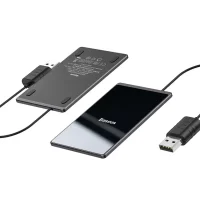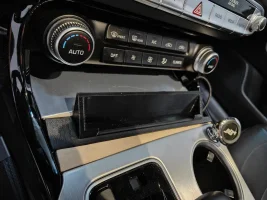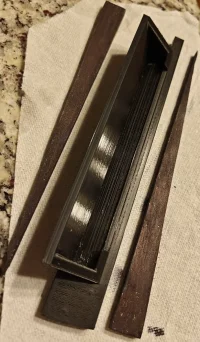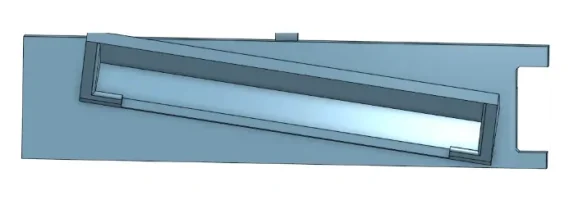Seaph03nix
Newish Member
- Joined
- Nov 6, 2025
- Messages
- 7
- Reaction score
- 5
- Points
- 3
I'm planning a DIY project to upgrade the wireless charging pad in my 2022 Kia Stinger GT2. If I can pull it off, I'll detail the exact plans in the how-to / DIY forum. My plan is meant to be relatively reproducible, with parts sourced from 3d printing, a commercially available magnetic wireless charging puck, & a cigarette socket car adapter.
The current pad in my Stinger not only doesn't work properly (turns on / off intermittently) but also only charges at 5 watts wirelessly, as I believe is the case for all Stingers, which is not nearly fast enough. Newer iPhones (16+) support Qi 2.2 fast wireless charging at 25 watts, which I think is considerably fast enough even for a short 20-30 minute drive. I personally have an Android phone that supports 50-watt wireless charging, so in maximizing that potential, I plan on installing a 50-watt wireless charging puck.
To upgrade it, I purchased a 50-watt (AirVOOC) magnetic wireless charging puck. The puck comes with a built-in fan to resolve the heat dissipation issue that's present even in the 5-watt wireless charging pad. A similar Qi 2.2 25-watt wireless charging puck with a built-in fan can be found on Amazon for $50 a piece, $30 for 2 pieces, or $22 for 4. The dimensions for my 50-watt wireless charging puck should be very similar to those of the Qi 2.2 25-watt wireless charging puck I linked to, but I'll try to develop a plan for both options, including a separate 3d printing file for the Qi 2.2 25-watt wireless charging puck I linked to, for reproducibility for those with iPhones.
I plan on removing the factory wireless charging pad + cover, then designing a 3D printable housing case that houses my wireless charger with holes for the cable to plug into the wireless charging puck as well as for ventilation, print the housing case, and install the 3d printed housing with the wireless charging puck inside, plus wire the cabling to a 12 volt, 8.5 amp cigarette socket car power adapter with power output protocols specifically designed for 80/ 100 watt SuperVOOC charging protocols (which I also already purchased). A similar PD 50-watt cigarette socket car power adapter can be used for the Qi 2.2 25-watt wireless charging puck I linked to. I'd like to hide the wiring and the cigarette socket adapter behind the dashboard.
The first challenge I'll encounter is that I need the dimensions of the factory wireless charging pad and cover. From what I gather, the rubber cover can be removed easily, so that's simple to take out and measure. However, the wireless charging pad is a bit trickier to remove and requires disassembling some of the center console. Is there any online resource that I can find these dimensions? Or will I have to take out the factory wireless charging pad and measure it manually? If anyone happens to have the measurements for the wireless charging pad or has one loose that they can measure, I would greatly appreciate the help. Thanks.
Note: I can't post links yet as I am a new user but I will update with link when I can.
The current pad in my Stinger not only doesn't work properly (turns on / off intermittently) but also only charges at 5 watts wirelessly, as I believe is the case for all Stingers, which is not nearly fast enough. Newer iPhones (16+) support Qi 2.2 fast wireless charging at 25 watts, which I think is considerably fast enough even for a short 20-30 minute drive. I personally have an Android phone that supports 50-watt wireless charging, so in maximizing that potential, I plan on installing a 50-watt wireless charging puck.
To upgrade it, I purchased a 50-watt (AirVOOC) magnetic wireless charging puck. The puck comes with a built-in fan to resolve the heat dissipation issue that's present even in the 5-watt wireless charging pad. A similar Qi 2.2 25-watt wireless charging puck with a built-in fan can be found on Amazon for $50 a piece, $30 for 2 pieces, or $22 for 4. The dimensions for my 50-watt wireless charging puck should be very similar to those of the Qi 2.2 25-watt wireless charging puck I linked to, but I'll try to develop a plan for both options, including a separate 3d printing file for the Qi 2.2 25-watt wireless charging puck I linked to, for reproducibility for those with iPhones.
I plan on removing the factory wireless charging pad + cover, then designing a 3D printable housing case that houses my wireless charger with holes for the cable to plug into the wireless charging puck as well as for ventilation, print the housing case, and install the 3d printed housing with the wireless charging puck inside, plus wire the cabling to a 12 volt, 8.5 amp cigarette socket car power adapter with power output protocols specifically designed for 80/ 100 watt SuperVOOC charging protocols (which I also already purchased). A similar PD 50-watt cigarette socket car power adapter can be used for the Qi 2.2 25-watt wireless charging puck I linked to. I'd like to hide the wiring and the cigarette socket adapter behind the dashboard.
The first challenge I'll encounter is that I need the dimensions of the factory wireless charging pad and cover. From what I gather, the rubber cover can be removed easily, so that's simple to take out and measure. However, the wireless charging pad is a bit trickier to remove and requires disassembling some of the center console. Is there any online resource that I can find these dimensions? Or will I have to take out the factory wireless charging pad and measure it manually? If anyone happens to have the measurements for the wireless charging pad or has one loose that they can measure, I would greatly appreciate the help. Thanks.
Note: I can't post links yet as I am a new user but I will update with link when I can.









